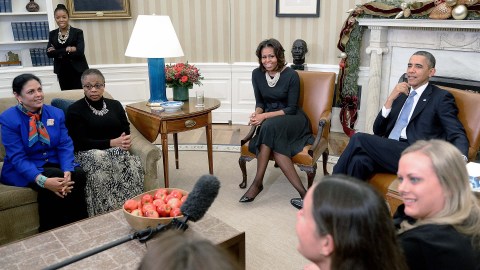“Amplification”: The Clever Method Women in the White House Use to Be Heard

The White House is a tough environment for anyone to work in, but it’s arguably more difficult if you’re a woman. From the long hours and rapid pace to the fact that men are three times more likely to interrupt women while speaking than men, females in the White House have to fight to make themselves heard.
And they do. The women in President Obama’s administration banded together and used what they called “amplification” to ensure that they had equal say in every conversation. As Quartz reports, “When a woman made a good point, another woman would repeat it, and give credit to the originator. This made the idea harder to ignore, or to steal.” A former Obama aide told The Washington Post:“We just started doing it, and made a purpose of doing it. It was an everyday thing.” Obama reportedly noticed, and began calling more frequently on women and junior aides.
The amplification technique is also known as shine theory. It works like this: befriend and support successful people in order to promote both of you. New York Magazine puts it more simply: “I don’t shine if you don’t shine.” Writer Ann Friedman elaborates: “When you meet a woman who is intimidatingly witty, stylish, beautiful, and professionally accomplished, befriend her. Surrounding yourself with the best people doesn’t make you look worse by comparison. It makes you better.”
Not only are female White House staffers setting a great example, they’re reinforcing the benefits of repetition. Research out of Cornell University states that “spaced repetition… uses periodic review of content to improve long-term [memory] retention.” That means that by repeating a woman’s idea, it becomes more valid simply through the act of being repeated. If that sounds a bit far fetched, here’s persuasion expert Dan Pink explaining why:
Repetition has such strong benefits in conversation because it’s a mirroring technique. Mirroring is the act of consciously or subconsciously copying the speech patterns, body language, and even enthusiasm of a conversation partner. Former FBI crisis negotiator Chris Voss told Big Think that “when a person is mirroring who they talk to, mimicking their body language and enthusiasm, it is a signal that the two people are at ease with each other and have taken a similar point of view.” That technique gives credence to both participants in the conversation and leads to better overall expression of ideas, as Voss explains here:
As helpful and useful as these strategies are, they’re not a magic bullet for workplace equality. As Sheryl Sandberg famously explains in Lean In: “In the days of tokenism, women looked around the room and instead of bonding against an unfair system, they often viewed one another as competition… women wound up being ignored, undermined, and in some cases even sabotaged by other women.” Kerry Rubin and Lia Macko, authors of Midlife Crisis at 30, put it even more bleakly:
“What we discovered in our research is that while the empowerment part of the equation has been loudly celebrated, there has been very little honest discussion among women of our age about the real barriers and flaws that still exist in the system despite the opportunities we inherited.”
Those flaws need to be addressed in order for true gender parity in the workplace. But in the meantime, the women of President Obama’s staff are certainly doing their part to make it happen.





